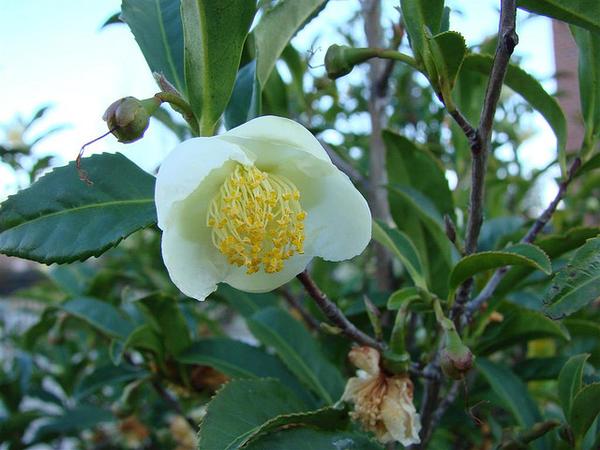Tea
Camellia sinensis
Family: Theaceae | Place of Origin: Southeast Asia
Origins and history:
Camellia Sinensis has been domesticated for about 3,000 years and originates from South-East Asia, specifically the Assam, Southern and Central China, Laos, Myanmar, and Thailand region. Currently, an estimated 67% of the world’s teas are grown in India, China, and Sri Lanka. Most production of these teas will be used for tea bags and beverages. Tea is highly incorporated into cultures around this area such as tea ceremonies. An example of tea drinking ceremonies include Japanese chadō. Chadō begun as a ritual for monks who drank tea for its caffeine to stay awake during long hours of meditation, currently, many regular people participate in tea ceremonies as a way to enjoy company with friends. Chadō is a ceremony dedicated to welcoming guests with a simplistic, yet aesthetic and orderly way. It takes place in a tea house, which is a small seperated building from the main house or even a dedicated room. There is usually hanging scrolls or flowers in the corner of the room called the tokonoma along with a small fireplace used to heat the tea kettle. The host will bring in tea utensils into the room and offer a light meal usually consistenting of specially made sweets. Next, the tea is prepared from making a “thicker” tea, using pulverized camellia sinensis leaves in hot water. The tea is then consumed usually in quiet, and after consumption, the guests and hosts are free to conversate among each other concluding the ceremony.

Identification characteristics
Camellia Sinensis is recognizable by having alternating simple serrated leaves and can be found to have white, yellow, and or pink flowers. Camellia Sinensis is typically around 6 – 8 feet tall when grown in large pots. When grown outdoors, it can reach upwards of a height of 6 feet with a width of 4 – 8 feet.
Uses and preparation
- Beverage preparation: The tea making process can be time consuming, as it is a multi step process and differential depending on the type of tea desired. The harvesting process depends on the tea desired, darker teas will have a later flush or harvest time than lighter teas. The post harvest process begins with withering and letting the plant wilt. The next step is bruising or rolling. Leaves of camellia sinensis are rolled, pressed, crushed, or broken down. Next, the leaves are left to oxidize and possibly fermentate for darker teas such as pu-erh. Finally, the leaves are dried and moisture is removed and then packaging up to be sold or consumed[3]. Drinking tea is even suggested to have some medicinal value to consuming it. Early studies are suggesting tea has anti-inflammatory and antioxidant properties. These medicinal properties come from the polyphenols found in tea; Catechins and epicatechins which are suggested to prevent diabetes by interactions with blood sugar levels[5]. The concentrations and appearance or abesence of these compounds depends on the tea type, how it was made, and when it was harvested.
- Ornamental uses: Camellia Sinensis is also used for other purposes besides beverages and for its health benefits. Camellia Sinensis makes for beautiful ornamental landscapes and shrubbery. Oils can be extracted from the leaves and flowers to produce essential oils, culinary oils, and even lamp fuel!